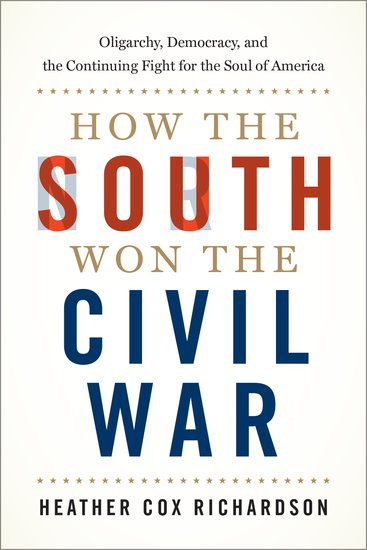In her new book How the South Won the Civil War: Oligarchy, Democracy, and the Continuing Fight for the Soul of America, Heather Cox Richardson contends that the United States was founded on a “paradox”: a North that tended toward democracy, and a South designed for oligarchy. Although the Union defeated the Confederate Army, Richardson writes, the Civil War did not eliminate the Confederate worldview; instead, the American West became a place for this oligarchic ideology to grow and spread. While Richardson overstates the racially egalitarian nature of the North, she does effectively trace the movement of this Confederate oligarchic ideology from the Southern Democrats of the nineteenth century to the modern Republican Party. Today, she argues, we have reached a watershed moment: either we will guarantee the rights and freedoms of civic participation to all, or we will risk allowing a small group of oligarchs to dictate the lives and interests of the rest.
Since the founding of the United States, Northerners and Southerners disagreed about who should exercise authority in the republic. Some founders, such as Northerner John Adams, insisted that the institution of slavery ran contrary to the principle of equality; others like Thomas Jefferson, a Southerner, argued for the maintenance of a racial hierarchy in the United States. While the rights guaranteed at the 1787 Constitutional Convention extended only to white men with property, the North emerged as a more democratic region that eventually rejected the enslavement of human beings and prioritized economic opportunity for the working class. Richardson paints a rosy picture of the North, where a person of modest means could purchase land, make use of natural resources to fish and log, and earn steadily increasing wages. Because the economy of the North was diversified, rather than reliant on one cash crop as it was in the South, political power was shared between members of different classes.
In the South, on the other hand, a class of agrarian oligarchs worked to concentrate wealth in the hands of a few, dominating the economy and politics of the new republic. Between the American Revolution and the Civil War, plantation owners utilized their wealth to acquire all of the cotton-producing land in the South, worked by a massive underclass of slaves. With the introduction of the cotton gin in 1794, cotton production increased exponentially; Southern oligarchs saw the potential for increased profits and sought to expand outside of the original borders of the United States. In one of their most successful efforts, they pushed President Andrew Jackson to seize Native American land with the Indian Removal Act. Southern senators were the driving force in acquiring new territory, extending the United States westward and bringing the institution of slavery with them. To secure the oligarchic way of life, John C. Calhoun and other Southern elites increased their power in Congress by creating new states where slavery was legal; they succeeded in the aftermath of the Mexican-American War (1846–1848), when the United States acquired territory that would become the states of Texas, Colorado, New Mexico, Arizona, Utah, and California.
